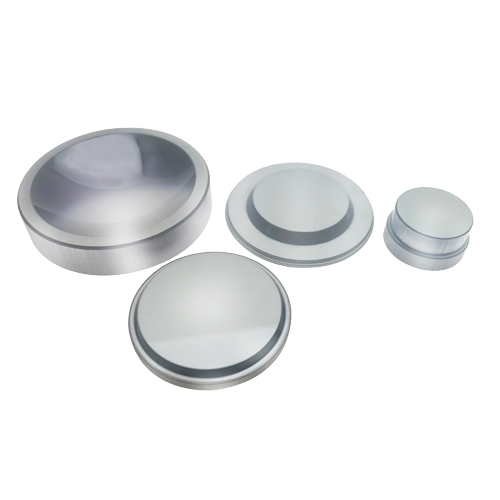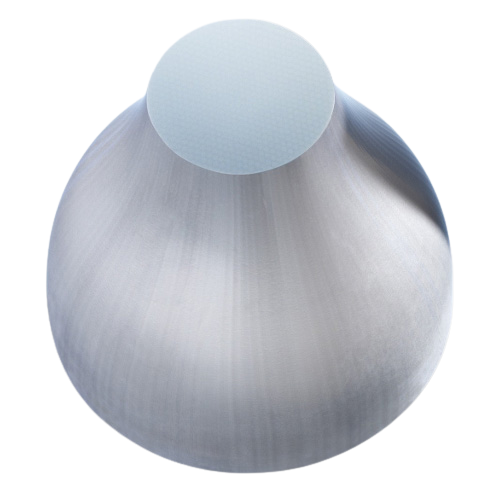Fiber Optic Component


Fiber Optic Plate (FOP)
A fiber optic faceplate is the optical equivalent of a zero-thickness window providing a high dielectric strength vacuum interface that can also be used for field-flattening, distortion correction, and contrast enhancement. faceplates are available in round, square, concave, or convex surfaces. They are used for cathode ray tubes, image intensifiers, CCD/CMOS windows, image plane transfer devices, and X-ray blocking applications, among others.
Our faceplates are used in the Scientific, Security Medical, Dental and Industries.
Faceplates for Digital Dental RadiographyOur versatility in faceplate manufacturing allows us to develop faceplates small enough for intraoral X-rays or large enough for panoramic X-rays of jaws and teeth. In intraoral imaging, thin, rectangular faceplates serve as links between an X-ray imaging screen and a CMOS detector. Since space is at a premium, only fiber optics can function in this way and still fit comfortably in a patient’s mouth.Large strip faceplates can capture a full-mouth image in one scan, making panoramic digital imaging possible. The images are also unmatched in resolution and clarity, while our products remain easy-to-use and comfortable for both patients and technicians.
Faceplates for ScientificGenetic sequencing applications benefit from the effective coupling of our faceplates and tapers with our microarrays. These microarrays can contain hundreds of thousands of sites for luminescent reactions that can be conveyed to CCD cameras during genome sequencing. When operating at levels of single photon detection, the vacuum-tight coupling and lack of shear distortion of our’s faceplates are key to effectiveness.X-Rays both damage CCD and CMOS chips and degrade their effectiveness with background noise. our engineers have optimized glass thickness and formulations to shield sensors from damaging X-rays. This allows for heightened image quality and extends the life of CCD or CMOS sensors.
Please free contact us for more detail product information and application. We’ll be happy to explain further.
Faceplate Standard Specifications Attribute Value Data Sheet Single fiber diameter 2.5μm / 3μm / 4μm / 6μm / 50μm / 70μm / 80μm / 100μm or customized Coefficient expansion at (20~300℃) 60~90 x10⁻⁷/℃ Vacuum tightness < 10⁻¹²Pa.m³/s Numerical aperture 1.0 Collimating transmittance >70% Diffuse light transmittance >65% Shear Distortion <30μm Gross Distortion <40μm Frame run-out ≤100μm EMA Absorber Interstitial / Annular / Without Core/Clad Ratio From 65/35~80/20 or customized Maximum Format diagonal 200mm Thickness from 0.3mm
Fiber Optic Taper (FOT)
Fused fiber optic tapers offer a low-distortion method of magnifying or, more typically, reducing an image for image transfer applications. Tapers manufactured from billets produced using our’s revolutionary process have zero shear distortion and blemish quality higher than normally available. Our large diameter fiber optic tapers (LDFOTs) are the largest available in the world. our’s tapers have many applications, including X-ray imaging, remote viewing, helmet mounted imaging, CCD coupling, image intensification, and X-ray crystallography.
Our FOT are used in the Scientific, Homeland Security, and Defense industries.
Scientific
Custom Tapers and Arrays
Acuri Technology is ability to create the world’s largest fused fiber optic tapers allows scientists to capture huge imaging areas with very high resolution. We dominates the X-ray crystallography field because of this ability. By manufacturing tapers up to 150mm in diameter, Our’s OEM customers can create single-module cameras that can capture larger images than any other source.
Custom engineering processes at Acuri Technology also allows our OEM partners to engineer solutions for specific needs. Taper arrays in various sizes and configurations continue to lead the push for larger and larger data collecting areas. Again, in X-ray crystallography, We has worked with OEMs to develop arrays of several tapers and CCD (charge-coupled device) sensors in a multiple-module mosaic. These configurations allow for large-area imaging without the loss of any resolution capabilities.
Tapers Outperform Optical Lenses in CCD Coupling
When coupling to CCD cameras in electron microscopy, Acuri Technology tapers create vacuum-tight seals and are five times more efficient than optical lens trains. In addition, Our fiber optic components can act as a barrier to protect the CCD surface from physical damage. They also allow for a larger active imaging area, from which the image can be minified and effectively transferred to the smaller CCD dimensions.
Defense
FOT-Protecting Our Homeland with Night Vision Technology
Acuri Technology’s tapers, key components in image intensifiers, are used to transfer night vision images to computers for analysis and storage. This fused fiber optics technology allows threats to be analyzed quickly and accurately.
Since image intensifiers used in night vision rely on a high-resolution, artifact-free image, our tapers play a vital role. They have the small-fiber diameter, high-fiber quality and low fixed-pattern noise required to create such high-quality images.
Our’s tapers are used in image intensifier coupling in order for the image intensifier to be able to relay the output image to a CCD sensor, computer, or other device. Fiber optic tapers are far superior to optical lenses for this process due to a much higher coupling efficiency, which yields a near-perfect image.
Fiber Optic Taper Standard Specifications Attribute Value Data Sheet Fiber Diameter (Small End) >4μm~12μm or others Numerical Aperture (N.A) Small End 1.0 Resolution ≥100lp/mm Magnification Ratio 1:2 / 1:3 / 1:4 or customized Core / Clad Ratio 60/40~ 75/25 or others EMA Absorber Interstitial / Without Coefficient expansion at (20~300℃) 60~90 x10⁻⁷/ ℃ Vacuum tightness <10⁻¹² Pa.m³/s Collimating transmittance >70% Diffuse light transmittance >65% Transmission range VIS 400nm - 900 nm Gross distortion <0.5% of effective area Shear distortion ≤30μm Frame run out ≤200μm Barrel/pincushion <3% of effective area

